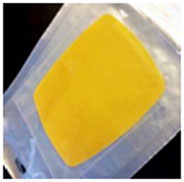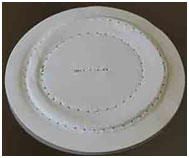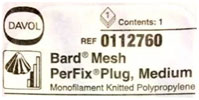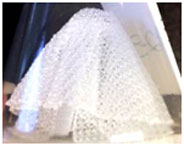Drug Watch Canada is launching an investigation into various hernia mesh products. Hernia
mesh is a screen-like surgical implant used to repair hernias,
a condition that occurs when an organ pushes through an opening in the muscle or tissue that
holds it in place. The use of a surgical mesh is viewed by the medical
community as the standard of care for hernia repair. While studies show that hernia mesh can
prevent hernia recurrence, several mesh products have been recalled
and patients report suffering from complications including infections, adhesions and bowel
obstructions that require hernia mesh removal surgery.
In fact, design defects have been discovered in a large number of hernia mesh products
currently on the market.
Drug Watch Canada has created this webpage in an attempt to educate the public on the
dangers of hernia mesh. Below you will find short summaries of many of the hernia mesh
products we are currently investigating.

A hernia occurs when an organ, intestine or fatty tissue squeezes through a hole or a weak spot in the surrounding muscle or connective tissue. Hernias often occur at the abdominal wall. Most hernias are caused by a combination of pressure and an opening or weakness of muscle or connective tissue. The pressure pushes an organ or tissue through the opening or weak spot.
Hernia repairs are common and doctors perform more than one million procedures every year in
the U.S. About 800,000 are to repair inguinal hernias and the rest are for other types of
hernias.
Non-Surgical: A patient's doctor may choose to monitor a hernia, a
treatment called "watchful waiting", if it is not causing problems or getting bigger, but
surgery is the only treatment that can repair a hernia.
Surgical: Doctors may perform hernia repair surgery with or without mesh.
Hernia repair surgery with mesh is called hernioplasty and without mesh, it is called
herniorrhaphy. After placing the mesh over the hernia defect, doctors use sutures,
tacks or surgical glue to hold the mesh in place. Over time, the patient's tissue should
grow into the pores of the mesh and strengthen the muscle wall.
A hernia can be surgically repaired using the conventional open method, or the less invasive
laparoscopic method.
In an open repair surgery, the surgeon makes an incision near the hernia to repair the weak
muscle area. Open repair that uses sutures without mesh is referred to as primary closure.
Primary closure is used to repair inguinal hernias in infants, small hernias, strangulated
or infected hernias.
In a laparoscopic surgery, the surgeon makes several small incisions in the abdomen that
allow surgical tools into the openings to repair the hernia. Surgeons will use laparoscopic
repair to fix a hernia reoccurrence because it avoids old scar tissue.
Surgical mesh is a medical device that is used to provide additional support to weakened or damaged tissue. The majority of surgical mesh devices currently available for use are constructed from synthetic materials or animal tissue. These pieces of mesh come in many sizes including patches or plugs.
Surgical mesh made of synthetic materials called polypropylene can be found in knitted mesh or non-knitted sheet forms. The synthetic materials used can be absorbable, non-absorbable or a combination of absorbable and non-absorbable materials. They can be coated with absorbable fatty acids, cellulose or collagen.
Animal-derived mesh are made of animal tissue, such as intestine or skin, that has been processed and disinfected to be suitable for use as an implanted device. These animal-derived mesh are absorbable. The majority of tissue used to produce these mesh implants are from a pig (porcine) or cow (bovine) source.
Non-absorbable mesh will remain in the body indefinitely and is considered a permanent implant. It is used to provide permanent reinforcement to the repaired hernia. Absorbable mesh will degrade and lose strength over time. It is not intended to provide long-term reinforcement to the repair site. As the material degrades, new tissue growth is intended to provide strength to the repair.
There are three techniques that surgeons use to repair hernias with surgical mesh.
1) Transabdominal preperitoneal (TAPP) repair
2) Totally extraperitoneal (TEP) repair
3) Intraperitoneal onlay mesh technique (IPOM)
The most common techniques used today are the TAPP and TEP techniques.
Incisional: Typically after an old surgical incision.
Umbilical: Near the belly button.
Inguinal: In the inner groin.
Femoral: Upper thigh/outer groin or the labia.
Recurrent: Previous hernia site.
Bilateral: Both left and right sides.
Ventral: Abdominal wall.
Hiatal: Inside the abdomen and upper stomach.
 The FDA continues to quickly approve untested
hernia mesh products, which benefits the medical device manufacturers and hurts the general public.
When a product is then shown to be defective, severely injuring thousands nationwide, the FDA is
slow to take any action.
The manufacturers of hernia mesh know of the life-threatening complications their products can
cause, but they don't warn the public or surgeons.
Educate yourself on the dangers of hernia mesh and warn those you know.
There are over 100,000 hernia meshes implanted every year in the United States and 30,000 in Canada.
Many have been recalled, but most of the most dangerous hernia meshes remain on the market and have
not been
recalled by the FDA or Health Canada. Bowel obstructions and severe infections are common
complications related to hernia mesh.
The FDA continues to quickly approve untested
hernia mesh products, which benefits the medical device manufacturers and hurts the general public.
When a product is then shown to be defective, severely injuring thousands nationwide, the FDA is
slow to take any action.
The manufacturers of hernia mesh know of the life-threatening complications their products can
cause, but they don't warn the public or surgeons.
Educate yourself on the dangers of hernia mesh and warn those you know.
There are over 100,000 hernia meshes implanted every year in the United States and 30,000 in Canada.
Many have been recalled, but most of the most dangerous hernia meshes remain on the market and have
not been
recalled by the FDA or Health Canada. Bowel obstructions and severe infections are common
complications related to hernia mesh.
In April of 2016 the FDA put out an article on hernia surgical mesh implants. The
following excerpt demonstrates just how out of touch the FDA is with how dangerous current
hernia mesh products are.
“Many complications related to hernia repair with surgical mesh that have been
reported to the FDA have been associated with recalled mesh products that are no longer on
the market. Pain, infection, recurrence,
adhesion, obstruction, and perforation are the most common complications associated with
recalled mesh. In the FDA’s analysis of medical adverse event reports to the FDA,
recalled mesh products were the main
cause of bowel perforation and obstruction complications.”
Just one month later, the manufacturer of the Physiomesh, Ethicon a subsidiary of Johnson and
Johnson, removed the
hernia mesh due to high rates of complications. Currently, the FDA’s website
still has no information on the Physiomesh recall. Ethicon continues to deny that the
Physiomesh was subject to a hernia mesh recall, but does admit that they withdrew the
product from the market. To date, there have been very few hernia mesh products actually
recalled. The majority of complaints that our lawyers receive are on products that have
not yet been recalled, or have simply been “pulled from the market.”
Ethicon also failed to provide Health Canada complete and accurate information with respect
to their Physiomesh products as it became available. In June of 2016, Health Canada issued a
Medical Device Product Recall for Physiomesh products to the general public and healthcare
professionals.

 What causes the complications can vary depending on the hernia mesh product. Many hernia
mesh products contain a type of plastic known as polypropylene,
the same material that is used to make many types of pelvic mesh and bladder slings. Here is
a
Polypropylene Material Data Safety Sheet (MSDS) for a type of
polypropylene used in some hernia
mesh products. The MSDS notes “Prohibited Uses: Applications involving permanent
implantation into the body.” However, the manufacturers of many hernia mesh products
continue to use polypropylene.
What causes the complications can vary depending on the hernia mesh product. Many hernia
mesh products contain a type of plastic known as polypropylene,
the same material that is used to make many types of pelvic mesh and bladder slings. Here is
a
Polypropylene Material Data Safety Sheet (MSDS) for a type of
polypropylene used in some hernia
mesh products. The MSDS notes “Prohibited Uses: Applications involving permanent
implantation into the body.” However, the manufacturers of many hernia mesh products
continue to use polypropylene.
 Yes, there are times in which mesh needs to be utilized to repair a hernia. The larger a
hernia is, the more likely a type of mesh is needed. If a mesh is required to repair the
hernia,
there are more than 50 different hernia mesh products to choose from. Various manufacturers
utilize a wide range of materials to make their hernia mesh.
These materials range from plastics to gels to pig skins. Later in this article, we will
cover some of the most dangerous types of hernia mesh.
Yes, there are times in which mesh needs to be utilized to repair a hernia. The larger a
hernia is, the more likely a type of mesh is needed. If a mesh is required to repair the
hernia,
there are more than 50 different hernia mesh products to choose from. Various manufacturers
utilize a wide range of materials to make their hernia mesh.
These materials range from plastics to gels to pig skins. Later in this article, we will
cover some of the most dangerous types of hernia mesh.

Long before hernia mesh was utilized to repair hernias, surgeons used the shouldice technique to repair hernias. The shouldice technique originated from the Shouldice Hospital in Ontario, Canada, where the technique is still favored to this day. For over 70 years, the Shouldice Hospital has maintained a success rate of 99.5% on primary inguinal hernia repairs. In most cases, general anesthesia is not even necessary to perform the shouldice repair. Typically local anesthetics, pain medication, sutures and a sedative is all that is required. Not having to rely on general anesthesia greatly reduces the risk associated with any surgery. It is time for surgeons in Canada to adopt the shouldice technique as opposed to using surgical mesh products. Hernia mesh creates risks to the health and safety of patients that are far more significant than the risks posed by the shouldice technique, and which far outweigh the utility of surgical mesh products.
Smaller hernias, such as hernias caused by laparoscopic surgery, don't require mesh to repair. Small hernias can easily be repaired with sutures by an experienced surgeon. The difficulty with hernias is they are very difficult to permanently repair. There is a high rate of hernia recurrence, both with sutures and with mesh. When sutures fail and the hernia comes back, the surgeon can usually try to stitch the hernia back up. When a mesh fails and the hernia comes back, many severe complications can occur. Also, the hernia is usually much larger after mesh failure. Abdominal tissue and muscle typically adheres to the mesh and must be removed with it.
The manufacturers of hernia mesh products funded studies to demonstrate that there was a lower rate of hernia recurrence when hernia mesh was utilized. These studies were lacking in many ways, such as the length of time that patients were monitored after mesh implantation and what were considered "normal complications." Our hernia mesh attorneys frequently talk to victims that were implanted with mesh 10 or 15 years ago and have just recently suffered from the mesh eroding into their bowels. Hernia recurrences and complications that happen 10 years later aren't captured by the studies.
Unlike sutures, which have relatively few and minor possible complications, hernia mesh frequently
causes life-threatening complications.
Hernia mesh can erode into the bowel, requiring multiple additional surgeries, weeks of
hospitalization, partial bowel removal, colostomies,
and more. The mesh failure frequently causes patients to experience a systemic infection. Our
lawyers have also recently observed high rates
of dental infections associated with mesh failure. Many victims report all of their teeth suddenly
rotting out.
Even if there is a slightly lower rate of hernia recurrence when mesh is used, it doesn't justify
the risk of life-threatening complications.
Hernia mesh is used to repair both ventral hernias and inguinal hernias. Various injuries and complications can occur depending on what part of the body the mesh is placed. A coated hernia mesh is also more likely to cause injuries such as infection than a non-coated hernia mesh. The follow is a list of the array of complications our hernia mesh lawyers have observed:
Any mesh with a coating is known as a composite mesh. Most of the manufacturers promote the meshes coating as a "barrier" and instruct surgeons to use the coating as a barrier. The FDA requires any "barrier" type of medical device to undergo Pre-Market Approval and pre-clinical studies to ensure the device's safety. Instead of conducting safety studies, companies just told the FDA that they wouldn't promote their hernia mesh as a "barrier." A majority of the meshes currently being used in hernia repair are untested composite meshes that have only been on the market for a few years. There is currently no reliable data on these hernia mesh products. Our hernia mesh attorneys are currently noticing a very high rate of complications associated with hernia meshes that are coated.
Due to the complications that polypropylene was causing when it came in direct contact with the bowel, the demand for composite hernia mesh skyrocketed. Any company with a composite mesh could rapidly increase its nationwide market share. Mesh products were already one of the most profitable medical devices a company could manufacture, many making over $100,000,000 a year! A composite mesh also sells for approximately 15 – 20 times more than an uncoated polypropylene mesh. Suddenly, every device manufacturer rushed to get a composite mesh on the market. Many companies created and sold several different types of composite hernia mesh at the same time. If one type of composite mesh caused too many side effects, the company would simply quit manufacturing that particular composite mesh. There are currently over 350,000 hernia repairs in the United States each year.
There are many different hernia mesh products available, many of which are manufactured by different
medical device companies.
The strengths and weaknesses of a hernia mesh lawsuit are in part determined by which company
manufactured the hernia mesh and the exact mesh
that was utilized. Below is a list of products that our lawyers receive a large number of complaints
about.
Bookmark this page and check back soon, this list is growing and we continue to add more unique
content every week!


Atrium – Maquet – Getinge Group
The C-Qur is a composite hernia mesh that came to market in 2006, and was initially marketed by Atrium Medical Corporation. Maquet, a subsidiary of the Getinge Group, acquired Atrium in 2011 and now manufactures the C-Qur hernia mesh. The FDA has issued several warnings letters and even sued Atrium Medical Corporation for violations. Recently, the FDA shut down one of Atrium’s facilities that manufactured the C-Qur hernia mesh. In July of 2013, Health Canada issued a Medical Device Recall against coated C-Qur meshes. The reason behind the recall was that coated C-Qur meshes can adhere to packaging liner when the product is exposed to excessive humidity for an extended period of time. Atrium has only issued recalls on the C-Qur’s packaging, not on the actual C-Qur hernia mesh itself.
The C-Qur hernia mesh has an Omega-3 Fatty Acid coating that causes severe allergic reactions. The C-Qur hernia mesh is also associated with life-threatening systemic infections. Removing the C-Qur mesh is extremely difficult and can result in further injury. The C-Qur hernia mesh remains on the market, even as lawsuits continue to mount. Our hernia mesh recall lawyers continue to receive frequent complaints related to the C-Qur hernia mesh. For more information, please visit our Atrium C-Qur Hernia Mesh Lawsuit page.


Ethicon – Johnson and Johnson
PhysiomeshThe Physiomesh was withdrawn from the global market in May of 2016. Ethicon maintains that they did not recall the Physiomesh. The Physiomesh was a composite hernia mesh. Multiple studies revealed that Ethicon’s Physiomesh had high rates of complications, including subsequent hernias and additional surgeries. According to Health Canada, recurrence/reoperation rates after laparoscopic ventral hernia repair using Ethicon Physiomesh Flexible Composite Mesh were higher than the average rates of the comparator set of meshes among patients in the registries. Ethicon admitted that they are unable to determine why the Physiomesh is defective, or how to decrease complications for those who had a Physiomesh implanted. Part of the problem was likely that the Physiomesh had a thick coating on each side of the mesh. The thick coating prevented the Physiomesh from properly incorporating with the host tissue. Prior to removing (not recalling) the Physiomesh from the market, Ethicon created a new hernia mesh called Physiomesh Open. For more information on Physiomesh, please visit our Ethicon Physiomesh Lawsuit page.


Davol – C.R. Bard
The Kugel hernia mesh was one of first and most well known hernia meshes to be recalled. C.R. Bard recalled several lots of the Kugel hernia patch in 2005, 2006 and 2007. The Kugel hernia mesh patch has a ring in the middle of the mesh to help it keep it’s shape. Multiple lots of the Kugel hernia mesh were recalled due to a large number of reported ring breaks. According to Health Canada, they received multiple complaint records of the PET recoil ring breaking, which could potentially lead to bowel perforation and/or chronic enteric fistulas. On February 6, 2006, Health Canada issued notice of recall effective January 9, 2006. Many patients have suffered bowel perforations as a result of the inner ring of the Kugel hernia patch breaking. Davol only recalled limited lots of the Kugel, claiming that certain lots had defective rings. Davol continues selling the Kugel hernia mesh to this day. The real problem with the Kugel hernia mesh is that it’s made of polypropylene, which shrinks over time. As the polypropylene mesh shrinks, more and more force is applied to the ring. Eventually, the ring breaks due to the shrinkage of the polypropylene. For more information on the Kugel hernia patch, please visit our Kugel hernia patch lawsuit page.




The PerFix Plug is another bare polypropylene mesh used to treat inguinal hernias. The PerFix plug has been observed to come unwoven over time. Many experience severe pain and difficultly exercising after being implanted with the Bard PerFix Plug. The PerFix Plug is another hernia mesh that has caused many men to loose a testicle. Learn more at our Bard PerFix Plug Lawsuit page.


Bard has a long history of creating mesh products out of polypropylene. With the Ventralex ST hernia mesh, Bard decided to add a coating similar to the coating used on the C-Qur hernia mesh. Like with the C-Qur, our hernia mesh lawyers are seeing severe inflammatory reactions to the Ventralex ST. Bard based the Ventralex ST hernia mesh off of a prior Bard hernia mesh design, the Kugel mesh. Bard recalled several lots of the Kugel hernia mesh approximately a decade ago. Bard has yet to issue a recall on any lot of the Ventralex ST hernia mesh. Learn more at our Bard Ventralex Lawsuit page. Ventrio ST and Ventralight ST are also included in the Ventralex ST lawsuit. Health Canada issued a Medical Device Recall against Ventralight ST mesh with Echo in April, 2014. There were customer complaints of an unsealed pouch for the included, separately packaged, sterile inflation assembly and inflation adapter. These components are used together to inflate the Ventralight ST mesh with the Echo PS positioning balloon, external to the patient, but within the sterile field.
The Sepramesh was introduced to the market in 2005 by Sanofi Genzyme, formerly known as Genzyme Biosurgical. C.R. Bard bought the license to manufacture and market the Sepramesh in 2007. Bard now sells the Sepramesh through its subsidiary Davol. The Sepramesh is a composite mesh with an absorbable coating. The Sepramesh is intended to “Separate” the polypropylene from the bowel. Learn more at our Davol Sepramesh Lawsuit page.

Covidien – Medtronic
The Parietex Composite (PCO) mesh is composed of a polyester base with a resorbable collagen barrier. The resorbable collagen barrier is intended to prevent the polyester base from adhering to the patient’s bowel. Covidien touts the Parietex as a unique material that “works with the body’s natural systems.” However, many of our clients would disagree. Learn more at our Parietex Lawsuit page.

Surgipro
The Surgipro is a non-absorbable multi-filament polypropylene mesh. Covidien and Medtronic’s website currently has surprisingly little information on the Surgipro. Covidien issued a limited hernia mesh recall in 2010 on certain lot numbers of the Surgipro. The Surgipro hernia mesh recall was due to packing defect that compromised sterility. Surgipro is also the name of the polypropylene sutures that Covidien manufacturers. More information on Covidien’s Surgipro coming soon.

Parietex Plug and Patch System
The Parietex Plug and Patch System is made from polyester weaved together with a partially semiresorbable polylactic acid (PLA) layer. Covidien was recently acquired by Medtronic for $42 billion. Covidien is also one of many defendant mesh manufacturers in the pelvic mesh litigation. More information on Covidien’s Parietex Plug and Patch System coming soon.
The below articles are on hernia mesh in general. Each hernia mesh subpage also contains additional case
specific scientific articles.
August 2016: Evaluation of Long-Term Surgical Site
Occurrences in Ventral Hernia Repair: Implications of Preoperative Site Independent MRSA
Infection.
632 patients were studied for two years after being implanted with hernia mesh. 31%
experienced complications within just two years. Complications included cellulitis,
necrosis, nonhealing wound, seroma, hematoma, dehiscence, and fistula. Patients
with a preoperative MRSA+ infection from any site (urine, blood, surgical site), might be at
an elevated risk for hernia mesh complications.
August 2016: Oral, Intestinal, and Skin Bacteria in Ventral Hernia Mesh Implants.
36 patients with failed hernia mesh were studied. All participants were found to have
gingivitis and 33% had infected gums and teeth. Oral bacteria was discovered on 43% of
explanted hernia mesh.The study discusses the difficulty in knowing the real rate of hernia
mesh infections, due to lack of standardized criteria to define infection, lack of follow-up
exams, and lack of intervention when complications arise. It notes that hernia mesh
infection is the most common reason for mesh removal.
June 2016: Sepramesh and Postoperative Peritoneal
Adhesions in a Rat Model.
The study notes that “postoperative peritoneal adhesions occurred at the extremities
of the mesh, where there was close contact between the polypropylene and viscera, or where
the fixation suture was placed.”
August 2015: Previous Methicillin-Resistant
Staphylococcus Aureus Infection Independent of Body Site Increases Odds of Surgical Site
Infection after Ventral Hernia Repair.
768 patients underwent hernia repair. 10% experienced a hernia mesh infection. 33% of
patients with a preoperative MRSA+ infection experienced a hernia mesh infection.
May 2014: Comparison of Outcomes of Synthetic Mesh vs
Suture Repair of Elective Primary Ventral Herniorrhaphy: A Systematic Review and
Meta-Analysis.
637 hernia mesh repairs and 1145 suture repairs were compared. Hernia mesh repair was
associated with a slightly lower rate of recurrence, but a higher rate of severe
complications. The authors admit that “further high-quality studies are necessary to
determine whether suture or mesh repair leads to improved outcomes for primary ventral
hernias.”
November 2013: Coated Meshes for Hernia Repair Provide
Comparable Intraperitoneal Adhesion Prevention.
Uncoated polypropylene was compared to various types of coated polypropylene placed
intraperitonally via laparoscopic procedure. The uncoated polypropylene hernia mesh resulted
in significantly more adhesions.
October 2013: Biologic Meshes are Not Superior to
Synthetic Meshes in Ventral Hernia Repair: An Experimental Study with Long-Term
Follow-Up Evaluation.
The study notes that “In laparoscopic incisional hernia repair, direct contact between
the prosthesis and the abdominal viscera is inevitable, which may lead to an inflammatory
reaction resulting in abdominal adhesion formation.” The authors advise additional
research is necessary, and to be wary of short-term experimental results on laparoscopically
placed hernia mesh.
October 2013: Intra
Peritoneal Polypropylene Mesh and Newer Meshes in Ventral Hernia Repair: What EBM
Says?
The authors are concerned about using polypropylene mesh (PPM) for laparoscopic hernia
repair. They question if paying 15-20 times more for a composite mesh is worth it. The study
notes “Complications of intraperitoneal PPM (adhesions, infection, intestinal
fistulization, sinus formation, seroma and recurrence) can occur with the newer mesh also.
There is no statistically significant difference in the incidence of these complications
between these meshes.”
August 2012: Ventral Hernia Repair with Synthetic,
Composite, and Biologic Mesh: Characteristics, Indications, and Infection
Profile.
The study notes that polypropylene “is unsuitable for intra-abdominal placement
because of its tendency to induce bowel adhesions.”
August 2011: Complications
of Mesh Devices for Intraperitoneal Umbilical Hernia Repair: A Word of Caution.
The surgeons note experiencing serious complications in several patients implanted with a
composite mesh. Injuries included small bowel resections and mesh removal. The study
notes “We think that, if preperitoneal deployment of such mesh devices is possible,
this should be the preferred position, notwithstanding the fact that these meshes have a
dual layer. There is a complete lack of convincing data on these mesh devices in the medical
literature. No long-term data have been published, and, for three of the four mesh devices
available, no publications on their use in humans were found.”
July 2011: Mesh
Infection in Ventral Incisional Hernia Repair: Incidence, Contributing Factors, and
Treatment.
The study discusses the need for a better identification, classification and reporting
systems for hernia mesh infections. It notes part of the difficulty is that hernia mesh
implants have a tendency to remain dormant for long periods of time. It can take years
before a hernia mesh infection is identified.
June 2009: The Problem of Mesh Shrinkage in Laparoscopic
Incisional Hernia Repair.
Laparoscopic hernia repair requires expanding the abdomen with approximately 3 liters of
gas. The surface area of the abdominal wall is stretched by about 80% during laparoscopic
repair. Surgeons must anticipate significant mesh shrinkage in laparoscopic hernia repair.
Mesh shrinkage remains one of the unsolved problems of laparoscopic incisional hernia
repair.
If a hernia mesh fails within a few years and the same surgeon that implanted the mesh removes the
mesh, the surgeon will sometimes report the complication to the manufacturer. It is then the
manufacturers duty to determine if the complication warrants notifying the FDA. Through our
investigations, our lawyers have uncovered that many manufacturers fail to report adverse events
related to hernia mesh to the FDA. Surgeons will also occasionally file adverse event reports
directly to the FDA, but the process is very time consuming.
As a result, the FDA is only aware of a very small percentage of total hernia mesh complications.
The manufacturers of hernia mesh then cite to low rates of hernia mesh complications reported to the
FDA as evidence that hernia mesh is safe!
If you have suffered hernia mesh complications, you can alert Health Canada. You can also alert
Health Canada by filing a hernia mesh lawsuit against the manufacturer of the mesh. When a
manufacturer is notified of a pending hernia mesh lawsuit, the manufacturer must report the basis of
the hernia mesh lawsuit to Health Canada. Medical device companies are allowed too much discretion
as to whether they must notify Health Canada when a surgeon reports a hernia mesh adverse event. The
medical device companies do not have discretion on reporting a hernia mesh lawsuit to Health Canada.
The companies must report every single hernia mesh lawsuit to the proper body.
The hernia mesh industry is one of the most lucrative medical device markets and is controlled by
the most powerful medical device and pharmaceutical companies on the planet! This is not going be an
easy or short fight, but an increase in public awareness will only help. Drug Watch Canada has
received an overwhelming amount of positive feedback regarding the information provided on our
website on different types of hernia mesh. Numerous people nationwide have called us and thanked us
for warning them about the dangers of polypropylene hernia mesh and preventing them from undergoing
implantation. We are also going to start going more in-depth on the problems with hernia mesh and
start going over the actual documents that are available to the public (documents obtained through
discovery are confidential).
Thanks for your help spreading the word on the dangers of hernia mesh and polypropylene! The hernia
mesh market is a highly profitable (criminal) enterprise that the medical device manufacturers are
going to great lengths to defend. It's important that the public learns WHY there are hernia mesh
lawsuits, not just that there are hernia mesh lawsuits. Just because a mesh is "new" doesn't mean
it's safe!
Please call 1-800-653-5374 to speak to one of our trained hernia mesh team members. An attorney and
a medical professional will look over your hernia mesh case and let you know what they believe the
best course of action is for you. Drug Watch Canada does not handle class actions. Each claim is an
individual hernia mesh lawsuit. The specific facts of your case will determine if your hernia mesh
lawsuit is compensable and to what amount. Drug Watch Canada represents hernia mesh victims
nationwide. All case evaluations and consultations are FREE, CONFIDENTIAL, and carry NO RISK or
OBLIGATION. Call 1-800-653-5374 for a hernia mesh lawsuit evaluation. Follow our Facebook page to
stay up-to-date on the latest hernia mesh litigation updates.
If you wish to obtain more information on potential compensation or to be kept advised of the status of this class action lawsuit, please fill out the form below.